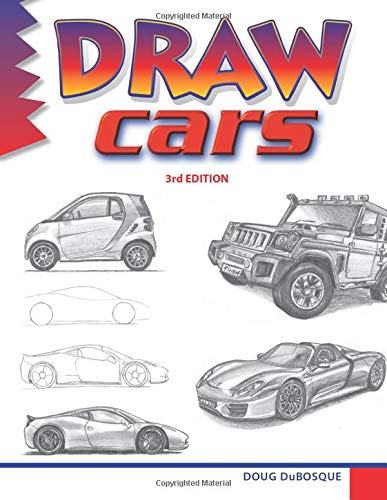-
Draw Cars
Doug DuBosque
Paperback (Peel Productions, Incorporated, Jan. 5, 2015)Featuring 2015 model year cars, including the Lamborghini Hurucán, Corvette, and BMW i8 Spyder!Whether your goal is to draw the latest supercars, transform your Uncle Bill’s ratty ol’ pickup into a Defender of Democracy, or make your next school-bus ride something to really talk about, this book is for you. You’ll find clear, step-by-step instructions, helpful tips, and plenty of encouragement. .Grab a pencil and let’s get started! Q
Q
-
Draw Really Cool Stuff
Doug DuBosque
Hardcover-spiral (APG Sales & Distribution, Jan. 1, 2015)Really Cool Stuff has been hailed one of the best drawing books on the market by readers and educators. Discover hundreds of exciting and fun images to draw! This complete set of six-books-in-one teaches how to draw cars, insects, dinosaurs, rainforest animals, ocean creatures and desert animals with simple step-by-step instructions.
-
Draw Dinosaurs
Doug DuBosque
Paperback (Peel Productions, Incorporated, Jan. 25, 2015)Tyrannosaurus, Velociraptor, Maiasurus and more! Inside, you’ll find step-by-step instructions, from beginning sketch to finished drawing. You’ll be surprised how easy it is to draw–without tracing!Grab a pencil and let’s get started!
-
Draw 3-D
Doug DuBosque
Paperback (F+W Media, Sept. 30, 2000)3-D means "three dimensional." It's easy to draw from side to side on your paper, using its width. It's easy to draw from top to bottom on your paper, using its height. But how do you draw something going away from you, into the distance? How do you create depth (the third dimension) in your drawing?What I want to teach you is linear perspective, a technique first developed almost 500 years ago, during the Renaissance. As you flip through my illustrations, this may seem like really complicated and technical stuff. And it is ... sort of. Those clever artists who figured this out weren't trying to make your life easy! They only wanted to make realistic pictures.Fortunately, you'll find that the basics really are pretty simple. Better, you don't need much beyond the basics to make some pretty cool drawings. Best of all, perspective can make your drawings look real in a way you can't achieve without it.You'll need a few supplies, some patience, and a positive attitude. Expect to make mistakes as you learn, and keep a smile on your face: with each mistake you learn another way not to do it!What you need...Find a comfortable place to draw - with decent light, so you can see what you're doing.A mechanical pencil works best for this type of drawing. Have a ruler or straightedge handy. It's very difficult to draw in perspective without one.If you have one, use a T-square and triangle.You'll probably want a separate eraser (the eraser on your pencil will disappear quickly). My favorite type is a kneaded type, available in art supply and craft stores.Patience: pay attention to the concepts. Do plenty of practice drawings! Y
Y
-
Draw Animals: Ocean - Rainforest - Desert - Grassland
Doug DuBosque
Paperback (Peel Productions, Incorporated, Nov. 23, 2015)Step by step instructions, both in writing and pictures, lead you through the process of creating dazzling drawings of some truly amazing creatures.Draw Animals includes the complete lessons from four books:• Draw Ocean Animals• Draw Rainforest Animals• Draw Desert Animals• Draw Grassland AnimalsEach animal includes scientific name, and facts about size, location, and more!Grab a pencil and let’s get started! R
R
-
Draw 3-D: A step-by-step guide to perspective drawing
Doug DuBosque
Paperback (Peel Productions, Incorporated, Dec. 27, 2014)3-D means "three dimensional."It's easy to draw from side to side on your paper, using its width. It's easy to draw from top to bottom on your paper, using its height. But how do you draw something going away from you, into the distance? How do you create depth (the third dimension) in your drawing?What I want to teach you is linear perspective, a technique first developed almost 500 years ago, during the Renaissance. As you flip through my illustrations, this may seem like really complicated and technical stuff. And it is … sort of. Those clever artists who figured this out weren't trying to make your life easy! They only wanted to make realistic pictures.Fortunately, you'll find that the basics really are pretty simple. Better, you don't need much beyond the basics to make some pretty cool drawings. Best of all, perspective can make your drawings look real in a way you can't achieve without it.You'll need a few supplies, some patience, and a positive attitude. Expect to make mistakes as you learn, and keep a smile on your face: with each mistake you learn another way not to do it!What you need...Find a comfortable place to draw - with decent light, so you can see what you're doing.A mechanical pencil works best for this type of drawing.Have a ruler or straightedge handy. It's very difficult to draw in perspective without one.If you have one, use a T-square and triangle.You'll probably want a separate eraser (the eraser on your pencil will disappear quickly). My favorite type is a kneaded type, available in art supply and craft stores.Patience: pay attention to the concepts. Do plenty of practice drawings!
-
Draw 3-D: A step-by-step guide to perspective drawing
Doug DuBosque
eBook (Peel Productions Inc., Jan. 26, 2015)3-D means "three dimensional."It's easy to draw from side to side on your paper, using its width. It's easy to draw from top to bottom on your paper, using its height. But how do you draw something going away from you, into the distance? How do you create depth (the third dimension) in your drawing?What I want to teach you is linear perspective, a technique first developed almost 500 years ago, during the Renaissance. As you flip through my illustrations, this may seem like really complicated and technical stuff. And it is … sort of. Those clever artists who figured this out weren't trying to make your life easy! They only wanted to make realistic pictures.Fortunately, you'll find that the basics really are pretty simple. Better, you don't need much beyond the basics to make some pretty cool drawings. Best of all, perspective can make your drawings look real in a way you can't achieve without it.You'll need a few supplies, some patience, and a positive attitude. Expect to make mistakes as you learn, and keep a smile on your face: with each mistake you learn another way not to do it!What you need...Find a comfortable place to draw - with decent light, so you can see what you're doing.A mechanical pencil works best for this type of drawing.Have a ruler or straightedge handy. It's very difficult to draw in perspective without one.If you have one, use a T-square and triangle.You'll probably want a separate eraser (the eraser on your pencil will disappear quickly). My favorite type is a kneaded type, available in art supply and craft stores.Patience: pay attention to the concepts. Do plenty of practice drawings!
-
Draw Ocean Animals
Doug Dubosque
Paperback (Peel Productions, Aug. 16, 1994)PLEASE NOTE: this book now joins three others in a single volume: Draw Animals. Get more for less! -- a wonderful gift for the budding artist you know. Including yourself ;-) Cut and paste this link: createspace.com/5874005 (We can't post a live link here.)Watching ocean animals, and learning about them, creates a sense of delight and awe. Watch how they move, how they hunt, how they hide! Wouldn't it be great to catch some of that excitement on your own drawings?This book shows you how, with step-by-step instructions. You'll be surprised how easy it is to draw, without tracing, a wide range of ocean animals.Grab a pencil and let's get started! S
S
-
Learn to Draw NOW!
Doug DuBosque
eBook (Peel Productions Inc, May 15, 2014)A note from the author, 22 years laterLearn To Draw Now originated after discussions with classroom teachers and school librarians whose artistic growth (at least in drawing) had stopped about age 8. They had absolutely no idea how to draw basic forms in 3-D, and hence found themselves in no position to pass on that useful knowledge to their students. I sought to remedy that, with a book that doesn’t necessarily feel like it’s for kids, because it isn’t.After 16 printings, we retired it a couple years ago. It’s a pleasure to be able to introduce it again as an ebook. I hope it will help you explore and enjoy the magical process of making marks on a two-dimensional piece of paper look three-dimensional!
-
Draw Dinosaurs
Doug DuBosque
Paperback (Peel, Aug. 10, 2000)From initial concept to finished art, the "Learn to Draw" series provides young and beginning artists with practical step-by-step instruction in a warm, friendly voice. Y
Y
-
Draw Grassland Animals
Doug Dubosque
Paperback (Peel, Sept. 30, 2000)From initial concept to finished art, the "Learn to Draw" series provides young and beginning artists with practical step-by-step instruction in a warm, friendly voice. O
O
